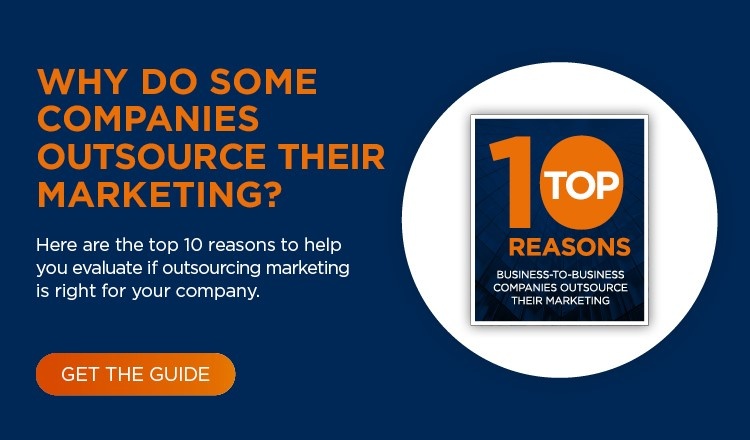The Business Case For Marketing In A B2B Company

Leaders of business-to-business companies (businesses that sell to other companies rather than to individual consumers) often wonder if the cost of marketing is worth the rewards. They wonder what kind of return they will get if they implement a strategic marketing plan that goes beyond the basic minimums of having a website and some sales sheets. For many business-to-business (B2B) companies, it’s difficult to determine how an investment in marketing will pay off. In short, they're not sure what the business case for marketing in their company is.

Making the business case for B2B marketing
Measuring the results of marketing is tough. In some ways, marketing is like IT. It involves a specific investment in tools, technologies and people. But the results come through many avenues and channels. So the expense is easy to see, but the returns are more nuanced and complex to measure.
That’s one of the factors that holds a lot of smart companies back from marketing.
But that’s a mistake. There is mounting evidence that marketing makes an impact. B2B companies are spending more on marketing – an increase of 18% over the last 4 years. On average, B2B companies spend 9% of their total operating budgets on marketing as of 2018, and plan to increase that by another 9% in 2019.
In short, more B2B companies implement strategic marketing every year – which means those who don’t get left farther and farther behind.
Four steps to calculate your business case for marketing
If your company is thinking about marketing but is having a hard time coming up with the math to make the business case, here’s a structure to help.
Consider these four ways that marketing improves performance for a company. These are not the only ways that marketing impacts a company, but they're a good place to start.
For each area, estimate the impact that marketing can have for your business – some areas will yield stronger opportunities than others.
1. Share of wallet (increasing sales to existing customers)
Do your existing customers know about your full product line? Could they be buying more from you than the one product or service that they currently buy?
Most B2B companies believe that their customers have a limited understanding of their full product line. Marketing is the tool by which companies raise awareness of their full product and service line to their existing customer base. This means they get more revenue (share of wallet) from their existing customers. It grows sales, and it builds a moat around existing customers by reducing their likelihood of turning to other suppliers.
To quantify the impact that marketing can make in this area for your company, consider the potential lift to your revenues if customers knew about your full product or service line.
Could you generate 5% additional revenues? 10% additional revenues? 15% additional revenues?
ACTION: Write down a percentage of your existing revenue that you could grow by educating existing customers about your full service and product line. Be realistic. Some companies have a big opportunity here and some companies have a minimal opportunity.
2. External image
Does the image that your company presents in the market accurately portray the business? Does it reflect the quality and integrity of the services you provide, the experience of your team, and the benefits that you deliver?
Put another way, does your market image prevent you from getting business?
Here’s an example: a boutique consulting company was networking among executives in national banks in order to generate business. The principals of the consultancy were well-respected and highly experienced. But the company’s online image was weak – their website looked amateur. As a result, the firm rarely got invited into the banks to speak with larger groups of potential customers. After overhauling their website to portray a more sophisticated image, the consultancy got significantly more traction. What changed? One of their contacts told them that he was now happy to introduce the firm to others in the bank, but he couldn’t before because their website made them look like a mom-and-pop shop.
Is a weak external image an issue for your company? Is it holding you back from getting new customers?
If you were to elevate your company’s image in the market, could you bring in 5% more revenues, 15% more, 40% more?
ACTION: Write down the amount of new business that you could gain if your online image was impressive rather than embarrassing.
3. Market awareness
Are you the best kept secret in your industry? Do all the companies and professionals who could be doing business with you know about you?
This is a major area of opportunity for most B2B companies. They might be fantastic at what they do, but no one knows they exist.
If you were to increase awareness of your business through marketing so that more potential customers knew about you, what could that mean for the business? A 10% lift? A 100% lift?
ACTION: Write down the amount of new business you could realistically gain if more companies knew you existed. Again, be realistic. In some cases this is a major opportunity, and in others it's less dramatic.
4. Lead generation
Does your phone ring or leads come in via web requests? Do you do any activities to promote your business and generate interest in the services and products you provide? Or is your sales team supposed to make endless cold calls in the hope of booking meetings with prospects?
Every company deals with an increasing level of competition, and if your competitors are doing a good job of lead generation online, it means that your business is suffering from declining inquiries. And your sales reps' calls are being returned less and less.
If you were to implement lead generation initiatives, could you increase your pipeline by 10%? 20%? More?
ACTION: Write down a realistic percentage here.
Next step: quantify the total impact of marketing
This list outlines 4 areas that marketing adds value for B2B companies. When you tally the percentages, what’s your number?
A business case example
A group of 20 CEOs recently went through this exercise.
There were significant differences between the businesses and the areas where they saw opportunity. The group as a whole tallied their impact numbers and the estimates ranged 21% - 155%.
One CEO of a $5M business estimated the potential uptick for his business at 28%. For him, that meant $1.5M in gross revenue, and at his gross margin of 30%, an additional $420,000 in contribution. If the marketing investment was $150,000, that would be an attractive ROI.
Not every company has numbers like that, but the exercise is a useful way to start estimating the ROI of marketing in your B2B company.
Building the business case for marketing in your company
Should your company invest in marketing in order to achieve revenue growth? What kind of investment level makes sense? We hope this exercise helps you evaluate the impact that marketing can have.
Find us on social:
.png?width=2361&height=488&name=Mezzanine%20Logo_Horiz_RGB_on%20blue%20(1).png)






